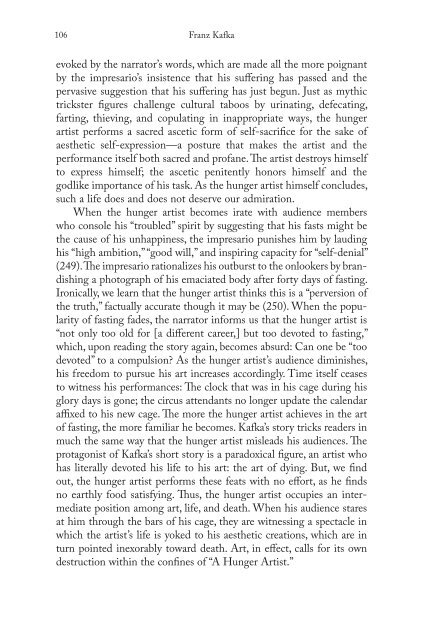Blooms Literary Themes - THE TRICKSTER.pdf - ymerleksi - home
Blooms Literary Themes - THE TRICKSTER.pdf - ymerleksi - home
Blooms Literary Themes - THE TRICKSTER.pdf - ymerleksi - home
You also want an ePaper? Increase the reach of your titles
YUMPU automatically turns print PDFs into web optimized ePapers that Google loves.
106<br />
Franz Kafka<br />
evoked by the narrator’s words, which are made all the more poignant<br />
by the impresario’s insistence that his suff ering has passed and the<br />
pervasive suggestion that his suff ering has just begun. Just as mythic<br />
trickster fi gures challenge cultural taboos by urinating, defecating,<br />
farting, thieving, and copulating in inappropriate ways, the hunger<br />
artist performs a sacred ascetic form of self-sacrifi ce for the sake of<br />
aesthetic self-expression—a posture that makes the artist and the<br />
performance itself both sacred and profane. Th e artist destroys himself<br />
to express himself; the ascetic penitently honors himself and the<br />
godlike importance of his task. As the hunger artist himself concludes,<br />
such a life does and does not deserve our admiration.<br />
When the hunger artist becomes irate with audience members<br />
who console his “troubled” spirit by suggesting that his fasts might be<br />
the cause of his unhappiness, the impresario punishes him by lauding<br />
his “high ambition,” “good will,” and inspiring capacity for “self-denial”<br />
(249). Th e impresario rationalizes his outburst to the onlookers by brandishing<br />
a photograph of his emaciated body after forty days of fasting.<br />
Ironically, we learn that the hunger artist thinks this is a “perversion of<br />
the truth,” factually accurate though it may be (250). When the popularity<br />
of fasting fades, the narrator informs us that the hunger artist is<br />
“not only too old for [a diff erent career,] but too devoted to fasting,”<br />
which, upon reading the story again, becomes absurd: Can one be “too<br />
devoted” to a compulsion? As the hunger artist’s audience diminishes,<br />
his freedom to pursue his art increases accordingly. Time itself ceases<br />
to witness his performances: Th e clock that was in his cage during his<br />
glory days is gone; the circus attendants no longer update the calendar<br />
affi xed to his new cage. Th e more the hunger artist achieves in the art<br />
of fasting, the more familiar he becomes. Kafka’s story tricks readers in<br />
much the same way that the hunger artist misleads his audiences. Th e<br />
protagonist of Kafka’s short story is a paradoxical fi gure, an artist who<br />
has literally devoted his life to his art: the art of dying. But, we fi nd<br />
out, the hunger artist performs these feats with no eff ort, as he fi nds<br />
no earthly food satisfying. Th us, the hunger artist occupies an intermediate<br />
position among art, life, and death. When his audience stares<br />
at him through the bars of his cage, they are witnessing a spectacle in<br />
which the artist’s life is yoked to his aesthetic creations, which are in<br />
turn pointed inexorably toward death. Art, in eff ect, calls for its own<br />
destruction within the confi nes of “A Hunger Artist.”

















